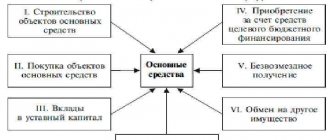Active and passive accounts
According to their economic meaning, accounts are divided into active and passive.
Active ones are used directly to account for the state and changes in the organization’s funds in the context of the types of their formation (for example, accounts 01, 04, 10, 20, 50, 51).
On these accounts, the initial and final balances, as well as increases in funds, are displayed on the debit side of the account, and decreases in funds are displayed on the credit side of the account.
Passive accounts serve to reflect the direct sources of formation and movement of the organization’s funds (for example, accounts 66, 67, 70, 80, 86).
In passive accounts, the beginning and ending balances, as well as increases in funds, are recorded against the loan. A decrease in economic assets is shown as a debit.
Accounting accounts
Accounting accounts are a system of grouping and current accounting of homogeneous funds according to certain criteria. The movement of accounting for each object occurs both in the direction of increase and decrease. The account is a table, the left side is Debit, the right side is Credit (from the Latin debet - must, credit - believes). Each account is given a code and name. The sum of the total of all debit transactions is called debit turnover , or debit turnover. The sum of all loan entries is called credit turnover , or loan turnover. The balance in the account is called the balance. The presence of an account balance means the presence of an accounting object at a certain point in time. The balance can be beginning or ending. The amount of the opening balance is equal to the corresponding balance sheet item at the beginning of the period. The final balance is formed by counting, and the corresponding total is transferred to the balance sheet at the end of the reporting period.
Finished works on a similar topic
- Coursework Accounts and double entry 400 rub.
- Abstract Accounts and double entry 270 rub.
- Test work Accounts and double entry 200 rub.
Get completed work or advice from a specialist on your educational project Find out the cost
Accounts are divided depending on indicators about the funds or sources of their education, and can be active and passive.
Double entry
All transactions directly carried out by an organization in the course of its work are reflected in the accounts simultaneously as a debit to one account and a credit to another account. This method, called double entry in accounting , provides direct interconnection of accounts and also has a control value. The only exception to this rule is off-balance sheet accounts, which reflect property that does not belong to the organization or assets and liabilities that are not taken into account on the balance sheet. In this case, the entry reflects only acceptance or deregistration.
For more information, see our material “Rules for maintaining accounting on off-balance sheet accounts.”
Example
The Omega organization purchased fixed assets in the amount of 600,000 rubles. without VAT and put it into operation.
The accountant will prepare the following entries:
- Dt 08 Kt 60 - 600,000 rub. — an object of non-current assets was acquired.
- Dt 01 Kt 08 — 600,000 rub. — the main asset has been put into operation.
- Dt 60 Kt 51 - 600,000 rub. — payment has been made to the supplier.
All facts of economic activity recorded using the double entry method in accounting are recorded in accounts in chronological order.
At the end of the period, the sum of the debit turnover of all accounts and the sum of the credit turnover of all accounts must be equal.
Examples
Let us explain this using standard wiring.
Double entry in simple transactions
- Dt 50 Kt 51 - 311,000 rub. — money has been credited from the current account to the cash desk. 50 and 51 are active accounts. Double entry reflects the simultaneous decrease in funds in the current account and their entry into the cash register.
- Dt 41 Kt 60 - 55,000 rub. - goods purchased. At the same time, the commodity mass increases on the active account 41 and a debt arises to suppliers for this product on the active-passive account 60.
- Dt 20 Kt 10 - 15,000 rub. — goods and materials were released into production. At the same time, the consumption is recorded on the Kt of the active 10 account and the increase in production costs on the Dt of the active account “Main production” (20).
Double entry in complex transactions
Let’s assume that 62,000 rubles were received from customers and 8,000 rubles from other debtors. Wiring: Dt 51 Kt 62.76 - 70,000 rub. — money has been transferred to the current account from buyers and other debtors. Here Dt 51 and the total loan amount 62, 76 are the same.
Another situation. Inventory from the warehouse for 50,000 rubles. released: to main proceedings in the amount of 30,000 rubles. and auxiliary production – 20,000 rubles. Wiring: Dt 20.23 Kt 10 - 50,000 rub. Here, the consumption of materials according to Kt 10 and the total debit amount 20, 23 coincide.
Chart of accounts
For a uniform generalization of the facts of economic activity using the double entry method in accounting by all business entities, the Ministry of Finance of Russia approved the chart of accounts. Directly on the basis of this document, the accountant of the business entity creates a working chart of accounts.
You can read more about it and, if you wish, download the chart of accounts in the article “Chart of accounts for accounting for 2020” .
Accounting accounts are divided into synthetic and analytical. The names and numbers of synthetic accounts are given in the chart of accounts. Synthetic accounts serve directly to group the financial indicators of the activities of a business entity.
Business transactions directly systematized into groups on accounting accounts in monetary terms as of a certain date constitute the balance sheet. The balance sheet looks like a table and consists of assets and liabilities.
You can read about what a balance sheet is and how to draw it up in the following articles:
- “Balance sheet (assets and liabilities, sections, types)”;
- “Procedure for drawing up a balance sheet (example)”.
Analytical accounts serve directly for a detailed analysis of business transactions, for example: by cost centers, by suppliers, customers, budgets, employees.
Example
In May, Omega LLC made payments to suppliers in the amount of 630,000 rubles from a current account with Sberbank PJSC, including:
- Organization "Granit" transferred an advance in the amount of 20,000 rubles.
- Organization "Market" paid for the supplied goods (tables) in the amount of 350,000 rubles. without VAT.
- The Stroika organization carried out office renovation work for Omega LLC in the amount of 260,000 rubles. excluding VAT, and Omega LLC fully paid for the work performed.
The accountant reflected these transactions with the following entries:
- Dt 60 Kt 51 - 630,000 rub.
- Dt 41 Kt 60 - 350,000 rub.
- Dt 26 Kt 60 - 260,000 rub.
In analytical accounting, these operations will be reflected as follows:
- Dt 60 "Omega" Kt 51 "Sberbank" - 20,000;
- Dt 60 “Market” Kt 51 “Sberbank” - 350,000;
- Dt 60 "Omega" Kt 51 "Sberbank" - 260,000;
- Dt 41 Table Kt 60 “Market” - 350,000;
- Dt 26 Repair Kt 60 "Omega" - 260,000.
Who invented double-entry bookkeeping?
Double entry used in accounting, including modern accounting
– one of the oldest information technologies. Meanwhile, who invented it is completely unknown. I have my own hypothesis about this. It was published several years ago, but the book's circulation is insignificant - I don't think that at least a dozen Khabra residents have read it. Aren't the others curious? To give the post the proper intrigue, I will inform you that a generation of young and talented ancient Roman IT specialists had a hand in the invention of double-entry bookkeeping. An image of one of them, behind a laptop of an antediluvian model, is attached.
Okay, I was joking about the ancient Roman programmer. What kind of ancient Roman is it, when is it ancient Greek? However, there are no jokes about double-entry bookkeeping. It makes so many people cry with burning tears that they can’t even dare to joke.
For those lucky ones who are far from double-entry bookkeeping, I’ll explain the situation.
The founder of double-entry bookkeeping is considered to be Luca Pacioli, who published the first accounting work in 1494, entitled “Treatise on Accounts and Records.” The mathematician monk never worked as an accountant for a day and had a very distant relationship with accounting, which is very noticeable from the treatise, which is simply boring to read, just as most modern accounting textbooks are boring to read. This alone indicates that Pacioli was not the author of the method, but an elementary compiler (which in those days was not considered shameful).
Most accounting historians are inclined to believe that the actual inventor remained unknown: for example, some medieval merchant or the entire merchant family, who kept the technology secret from competitors for decades or even centuries. Or not even a medieval family, but an older one - an ancient Roman one, for example.
I will say right away that I am also inclined towards the ancient Roman version. However, here you need to understand what the main difficulty is. The difficulty is not in obtaining any written evidence of the invention of double entry—there probably is none extant—but in understanding for what purposes double entry was invented.
The purpose of double entry is the most mysterious in the history of its invention!
Double recording itself is a fairly solid and tightly knit technology. It has a set of well-known advantages and a set of equally well-known disadvantages, but the fact that double entry is a technology cannot be denied.
But - every technology is intended for something, and double recording seems to be not intended for anything: the technology itself is like an alien one. Imagine a device that fell from the sky: wires, sensors, terminals and connectors of some kind, and it’s even more or less clear how it works... but the purpose as a whole is unimaginable. It's the same story with double entry.
Its device is quite cunning, but in a nutshell, it looks like this. There are two unequal quantities: A (asset) and P (liability). If you subtract P from A, you get the difference, of course. Let's call the difference K (capital).
We take the formula (the so-called balance equation): A – P = K
We move P to the right side, we get:
A = K + P
Just look how cool it turned out!
Now, if we begin to register the quantities A and P (which is the purpose of accounting), but together with them we also begin to register (not calculate, as suggests itself, but register!) the difference between them K (capital), then a double entry is formed with its debit and credit and the total transaction amount for them. Debit-credit, combined in one accounting entry, is the addition of equal values to equal values, the same with subtraction. What will happen in this case? The same values will turn out, what else could happen?!
Such simple arithmetic for the first grade, but why was it - this very accounting balancing - invented and put into practice, that is the question?
They explain it in different ways, but each time unconvincingly: either to check the books of account, or to calculate capital, or in connection with the emergence of joint-stock companies. The reasons, from my point of view, are all unconvincing. In Russia, they learned about double entry at the end of the 18th century; it took another half a century for double entry to be put into practice, however, even before that time, Russians kept accounting: regulations were issued, statements were filled out, property was recalculated. There was accounting, but, imagine, there was no double entry!
So I put forward my own hypothesis, explaining why the hell it was necessary to register K (capital) along with A (assets) and P (liabilities).
According to my version, double entry was invented in Ancient Rome, in connection with the holding of censuses (I am not original here).
Census is a population census conducted every 5 years. The qualification itself took place as follows. Each legally independent citizen, under an oath, provided information about himself: full name, place of birth, name of father or (for freed slaves) former owner, age and taxable property. Based on the property that a Roman owned, he was assigned one or another qualification category, and in general, his rights and privileges were determined.
Well, that’s great, but what does double-entry accounting have to do with it? But here's what it has to do with it.
The reference books say that those responsible for holding censuses in Ancient Rome were censors elected from among the consulars (former consuls). The censors had the right to reduce the number of civil rights that a Roman enjoyed based on the results of the census; they even had the right to remove a senator from the Senate. At the same time, according to the reference books, not only purely political and administrative considerations were taken into account, but also the personal life of each citizen, that is, the censors took on the function of guardians of morality.
Well, how did they introduce you to an official with such broad powers? I was not able to establish whether the censors had the right to deprive the Romans of civil rights only during censuses or between them, that is, on an ongoing basis, but I strongly suspect that they did. Otherwise, how could statesmen monitor the morality of their fellow citizens if qualifications were held every five years? The status of an official with such substantive functions as that of a censor had to be constantly maintained, therefore the powers of the censor were required to include the ongoing revision of qualification lists.
An educated guess? It seems reasonable to me.
Then imagine how the censors could revise the lists of Roman citizens in the intervals between censuses. The essence of the audit, regardless of its national characteristics and legal formalities, could come down to one thing: a censor was brought to a Roman citizen in order to check his property status - let’s not forget that the audit of the qualification lists of Roman citizens involved, first of all, checking the property status, and then the rest . Based on the results of the property check and accompanying observations, the censor determined: is the behavior of a given Roman citizen moral? Shouldn't this Roman's rights be diminished? Is he worthy to belong to a certain social stratum?
If I'm right, the whip with which the ancient Romans were forced to keep written records at home becomes clear: censors.
We come to the conclusion that every law-abiding Roman, out of fear of a visit from the censor, kept records of household property. This does not yet explain the invention of double entry, but it brings us closer to it, especially if we find out what kind of written records the ancient Romans could keep at the time of the census.
The main thing is not even which one, the main thing is on what medium.
In Ancient Rome, according to modern reference books, the following media were used: papyrus, wooden tablets, parchment, tree bark, clay shards, plaster. On which information medium did the venerable fathers of Roman families keep household records, and in what incomprehensible way is the medium used connected with the invention of double entry?
What medium did the ancient Romans use to record household property in writing?
We sweep away the tree bark, clay shards and plaster right away: it’s just hard to imagine.
I assume that papyrus was not used by the Romans for accounting purposes for the reason that it was still a bit expensive. Throughout the ancient period, papyrus was the main writing material for the Mediterranean countries, but only for certain types of writing work: for example, literary texts on papyrus scrolls were written down and legal contracts were drawn up, but daily business records were not, in order to save money. Otherwise, economic papyri would have been preserved in large quantities, but they were not preserved: that means they simply did not exist.
Then parchment codices, which as an information carrier are much more durable and attractive than papyrus scrolls? It's also unlikely. Parchment was more expensive than papyrus - cattle skin after all! - so its use in home accounting looks even less likely. Secondly, the use of parchment is not chronological.
To understand the sequence of events, I have compiled the following chronology. Figure out for yourself what happened and when, according to official reference data.
3 thousand BC
– the first surviving papyri;
578-534
BC. – establishment of qualifications, initially property;
mid 5th century
BC. – the importance of qualifications has increased greatly;
443 BC
– the position of censor was introduced;
312 BC
– holding the first monetary qualification;
OK.
180 BC – start of parchment production;
mid 1st century
BC. – the position of censor was abolished;
74 AD
– abolition of qualifications;
1st century
AD – the existence of codes is reliably attested;
2nd century
AD – invention of paper;
4th-5th centuries
AD – the scroll began to be replaced by the codex;
8th century
AD – penetration of paper into Europe.
11th century
AD – cessation of the use of papyrus as writing material.
Parchment began to be produced more than a hundred years after the first monetary qualification and two and a half centuries before their abolition. While the production of parchment was established, which is unlikely to have happened quickly, the census began to decline... and taking into account the high cost of parchment... and the fact that parchment codes appeared when the census was abolished... It is very doubtful that the ancient Romans who lived during the time of the census used to conduct their household accounting with parchment.
If historians are not lying, and household records in Ancient Rome, carried out during the time of censuses, were still written, it remains to be assumed that they were kept on diptychs - writing tablets made up of two parts, covered with a layer of wax: writing could be scratched on them with a stylus , and then erased. (The drawing on the ancient Greek vase does not depict a laptop, but a diptych writing instrument... you guessed it, of course).
How many diptychs were required to record the property of one family? Let's figure it out. If we assume that no more than forty lines could be written on one diptych (twenty on one board and twenty on the other - what do you think could fit more? Is it on a waxed surface with a sharp stick?), and the total number of entries was, let's say , a thousand (household utensils, pets, slaves, etc.), it turns out twenty-five diptychs... the size of a laptop. How would you like keeping a compact home account, not the largest family, on twenty-five laptops?
The assumption that household accounting was kept on diptychs is supported by the friendly mention by historians of a special counting room ( tablinum
) for storing household accounting documents.
The term tablinum
- “archive” is etymologically related to
tabula
- “board, slab, table”, and
tabella
- “plank, plank”.
So what kind of information media were stored in tablinums
? Are they really papyri or parchments?
And the most important.
When conducting a census, the Roman swore an oath about the value (total value balance), but not about property turnover. From the definition of qualifications in reference books, it does not in any way follow that ancient Roman legislation obliged citizens to keep income and expense records... and where is the evidence that the ancient Romans actually kept it, as is groundlessly assumed by most historians?
The difference between income-expense accounting and accounting of balances (remains), I hope, is clear: in the first case, it is recorded how much property left the farm and how much was received (income-expense), and in the second case, only cash property balances as of the current date are recorded. For balance accounting, the ability to add new entries on top of old ones was very useful and desirable. Something inexpensive and non-consumable was needed for daily rough accounting, and a simple waxed board was undoubtedly an affordable and common material and did not need to be thrown away when updating the record.
This is where everything converges into one dense logical point: the fact of keeping household records, which is quite unusual for today; balance accounting, which the Romans had the opportunity to carry out on media available to them; multiplicity of information media required for accounting; censors who had the right, under the pretext of a census check, to invade Roman homes; and the double entry that is the subject of our consideration.
Do you think that a high official who showed up at a Roman house to audit the property status would begin to recalculate the accounting indicators depicted on dozens, and perhaps hundreds of diptychs? No normal official, including an ancient Roman one, would have agreed to such a mockery from his point of view. How do you even imagine a dialogue between a censor and a Roman subject to censorship?
“Hello, I am a censor, I need the total value of your property.” "Twenty minutes." “How can you confirm?” “And there are ninety diptychs lying around in my tablinum. If you want, recalculate.”
No, the censor would first require that you familiarize yourself with the general figure of the current property status, and then, if there are doubts about the reliability of the accounting data, proceed to a detailed check. The censor would also not agree to wait until the owner of the family being audited adds up a thousand or more figures, wanting the final figure to be presented to him immediately.
Where could a Roman subject to a census check, at the first request of the censor, get the required indicator? It is clear that the indicator should have been calculated in advance, that is, it should have been in a calculated state constantly, in case of an unexpected visit.
In principle, fulfilling the censorship requirement is quite simple; you just need to have a calculated total amount along with the balances for each property position. If the censor is satisfied with the final amount, so much the better; if not, let him personally carry out an arithmetic check on the existing diptychs. You understand, it is impossible to demand more from the person being tested.
I assume that the Roman, who carried out household accounting, along with the remainder of his property as of the current date, wrote down the total amount on the diptych - the same amount that he swore during the census. When the property status changed, the Roman erased the outdated entry and made a new one, but at the same time - in case of a censor's visit - he kept a separate diptych with the total amount of his property.
Nothing impossible, right? The censor demands the total amount, and the head of the family politely replies:
“Please, here she is on my final diptych.”
Not understood? Let's do it again.
It was impractical for the Roman, who recorded changes in property balances on diptychs, to recalculate the once calculated total, so the Roman could and probably did act in a different way: he did not recalculate the total total according to indicators recorded on several (tens or hundreds) of diptychs, but made equivalent changes only to changed indicators, including in the overall total, thereby significantly simplifying arithmetic calculations. Simply put, the Roman was doing the accounting entries! This is how, in my opinion, double entry arose, taking it into account along with real objects (A - assets, and P - liabilities) of the total cost total (K - capital) and the methodological consequences arising from double entry, which are not yet completely obvious, but already recognizable. When the censor showed up at a Roman house, the owner presented him with diptychs stored in a tablinum as documentary evidence of his property status: first, the one on which the final result was recorded, and, if a more thorough check was necessary, the remaining diptychs, on which the balances for each type of property appeared.
The dialogue between the owner of the family and the censor looked different from the one presented earlier:
“Hello, I am a censor, I need the total value of your property.” "Twenty thousand sesterces." “Show me the result.” “Here you are, my final diptych. See for yourself what is written in it: twenty thousand sesterces, a penny for a penny.” “The figure gives me doubts. In particular, I doubt that your data on bulls is accurate.” “O great Jupiter, what an undeserved insult! I ask you, dear censor, to go to my family tablinum. Now I will find a diptych in which bulls are written... here it is, this diptych... Please see for yourself: I have four bulls.” “So where are they?” “In the field, dear censor, of course, in the field... But at the slightest doubt on your part, I can drive them into the stall. It will take a couple of hours, no more.” “No need, I believe you.”
Accounting for net worth in ancient Rome did not happen because someone very smart came up with a particularly advanced methodology out of the blue. No - if the dual methodology had been invented in other conditions, it would not have had the slightest chance of widespread distribution! The invention of double entry occurred for the reason that it was convenient for the common Roman man to record his own capital as an independent object, along with real property, on a waxed tablet - for nothing else.
This is the core of my reasoning - the very thing that none of the historians who adhere to the hypothesis of the origin of double entry in Ancient Rome, or in feudal Italy, or any other hypothesis, explains. Well, okay, double entry originated, but why there? and why exactly her? Yes, because, I answer, it was in Ancient Rome that unique political and economic conditions developed: home accounting, balance sheet accounting and the threat of a sudden check of the total property total, which made it methodologically advantageous to register equity capital as an independent object.
What happened next with double entry?
The Romans began using papyrus and parchment book codices. Later, paper penetrated Europe - an information medium that is widely used to this day - which allowed accounting subjects to maintain full-fledged income and expense records. With income and expense accounting, the need to account for capital as an independent object disappeared, so double entry should have lost all relevance for the Romans... nevertheless, K (capital) continued to be taken into account as an independent object!
Why did it happen? Historical mystery.
The incident of maintaining the accounting of equity capital in the conditions of income-expense accounting can only be explained by an established tradition, the habit of editing data on two diptychs, but not on one, after completing a business transaction. If another object arrived to replace the departed one, the records about these two objects were subject to correction; if the operation was uncompensated, non-reciprocal, the result - a diptych with data on capital - was also subject to correction. The habit of ruling several objects at once during one operation became so ingrained in the flesh and blood of the Romans that they could not give it up in the new conditions.
Censuses were abolished, and the Roman accounting of household property disappeared into oblivion. However, it was preserved by merchants and money changers (Argentarii and Trapedzites), for whom accounting remained an absolutely necessary and natural matter. The emergence of new information media changed accounting technologies and pushed the boundaries, but traders, accustomed over several centuries, retained the now unnecessary methodological technique left over from table-balance accounting as a harmless and unburdensome (at that time) atavism. Here, at the end of the 15th century, Luca Pacioli came to the forefront of history, having guessed to place the method of merchant records in a mathematical treatise, thereby immortalizing his name.
This is the hypothesis about the origin of double entry bookkeeping - no more fantastic than others, and just as unverifiable.
I don’t take all of them - my hypothesis and other hypotheses too - too seriously and in general am guided in this matter by the opinion that Nikolai Vasilyevich Gogol expressed in “Dead Souls”:
“At first the scientist... begins timidly, moderately, begins with the most humble request: is this not from there? Is it not from that corner that such and such a country received its name? or: doesn’t this document belong to another, later time? or: shouldn’t this people mean this kind of people? He immediately quotes these and other ancient writers and as soon as he sees some hint or, simply, it seemed like a hint to him, he gets a trot and is invigorated, talks to the ancient writers easily, asks them questions and even answers them himself, completely forgetting about that , which began with a timid assumption; it already seems to him that he sees it, that it is clear - and the reasoning is concluded with the words: this is how it was, this is the kind of people we need to understand, this is the point from which we need to look at the subject! Then publicly from the pulpit, and the newly discovered truth went to walk around the world, gaining followers and admirers.”
Active accounts
Active accounts keep records of funds (property, assets) of the enterprise. Opened on the basis of balance sheet asset items. The balance is always reflected in debit. The credit balance is an indicator of error. The receipt of funds is accounted for by debit, the decrease in funds, their disposal by credit. The account formula looks like this: $Balance_{final \ (by \debit)}=Balance_{beginning \(by \debit)}+Turnover_{(by \debit)}-turnover_{(by \credit)}$.
Example 1
At the beginning of the month, there were 6,000 rubles in the “Cashier” account; during the month, 35,000 rubles were received in the cash register. from buyers, 38,000 rubles were deposited into the bank account. Calculate the ending balance.
Figure 1. Account 50 “Cashier”






